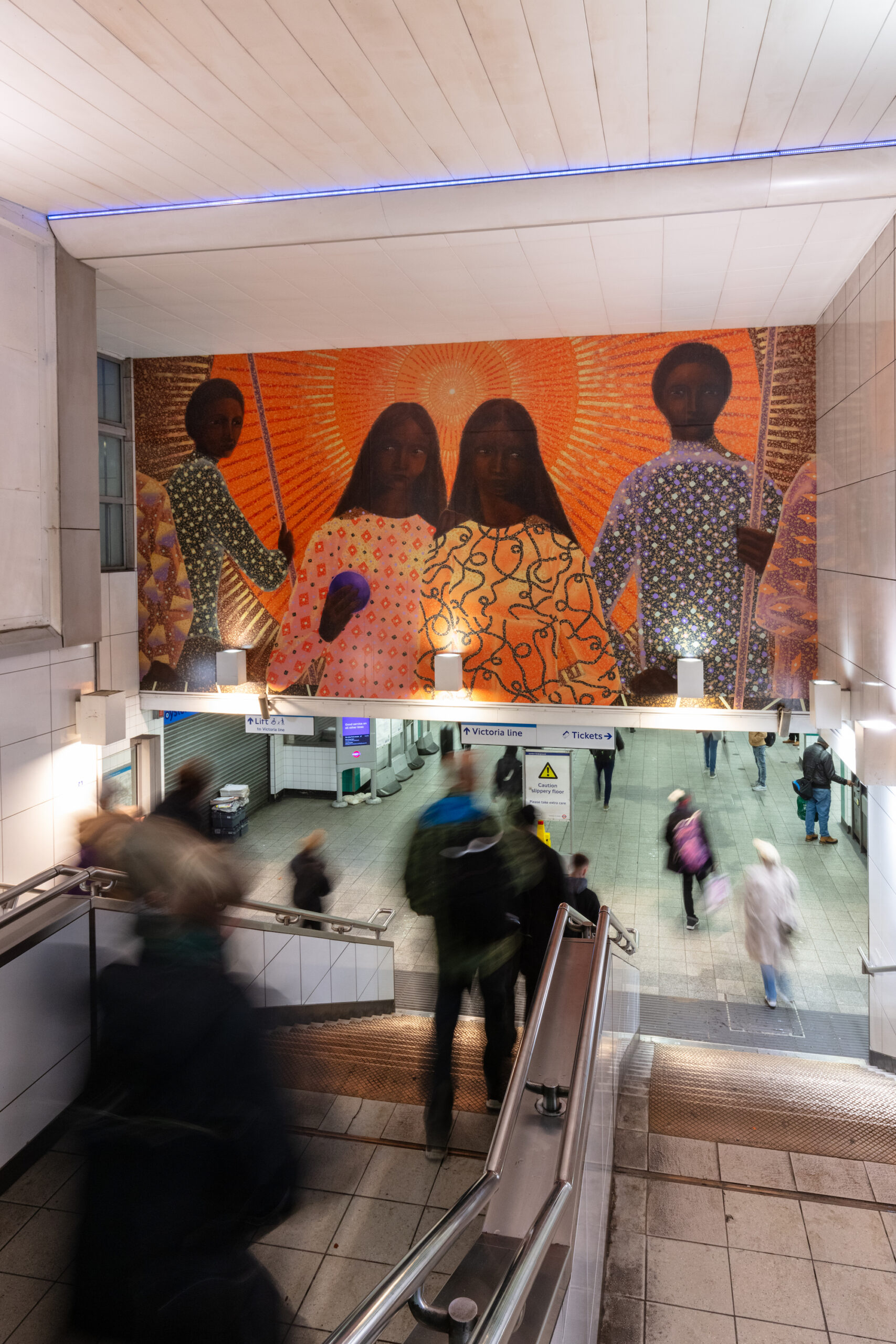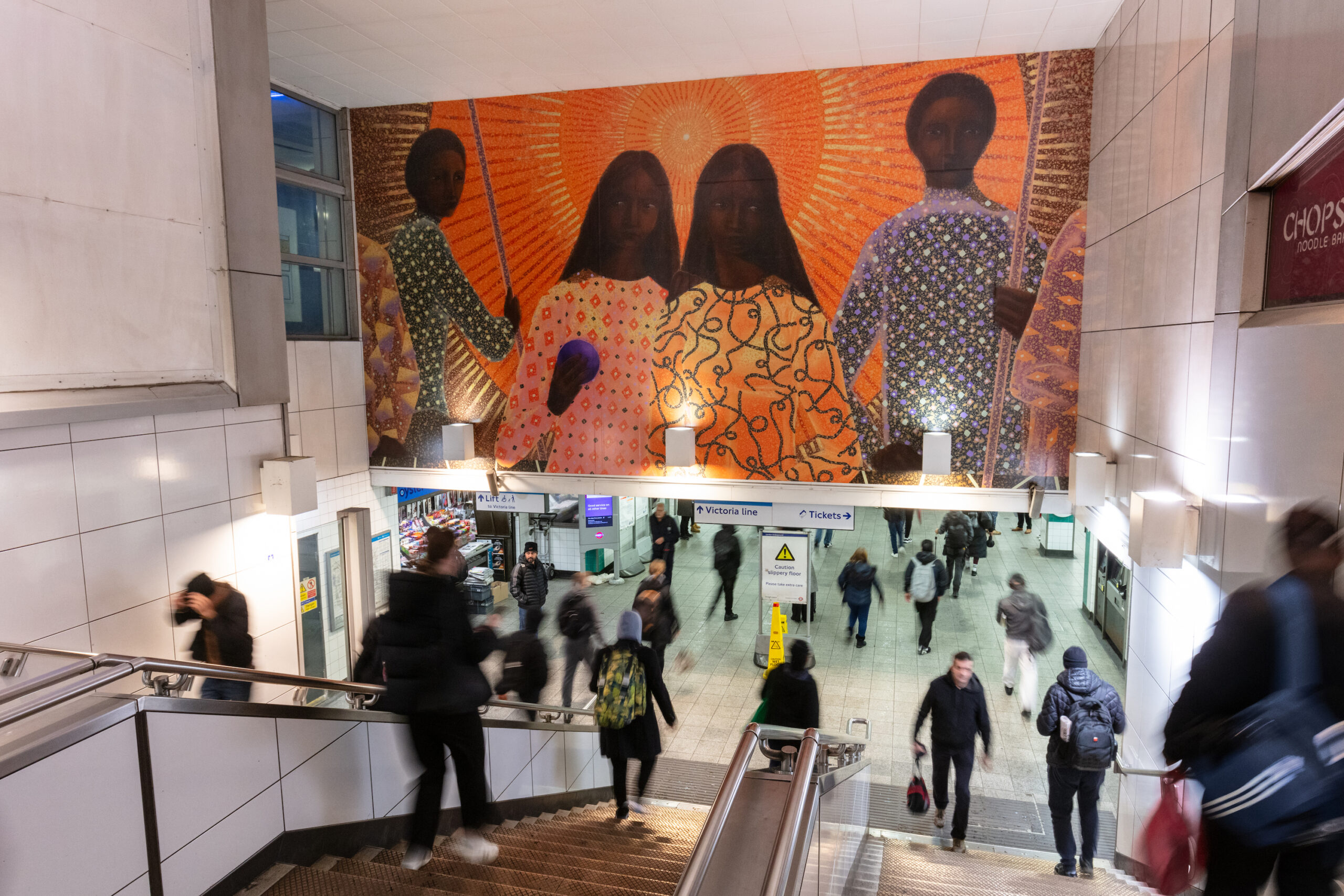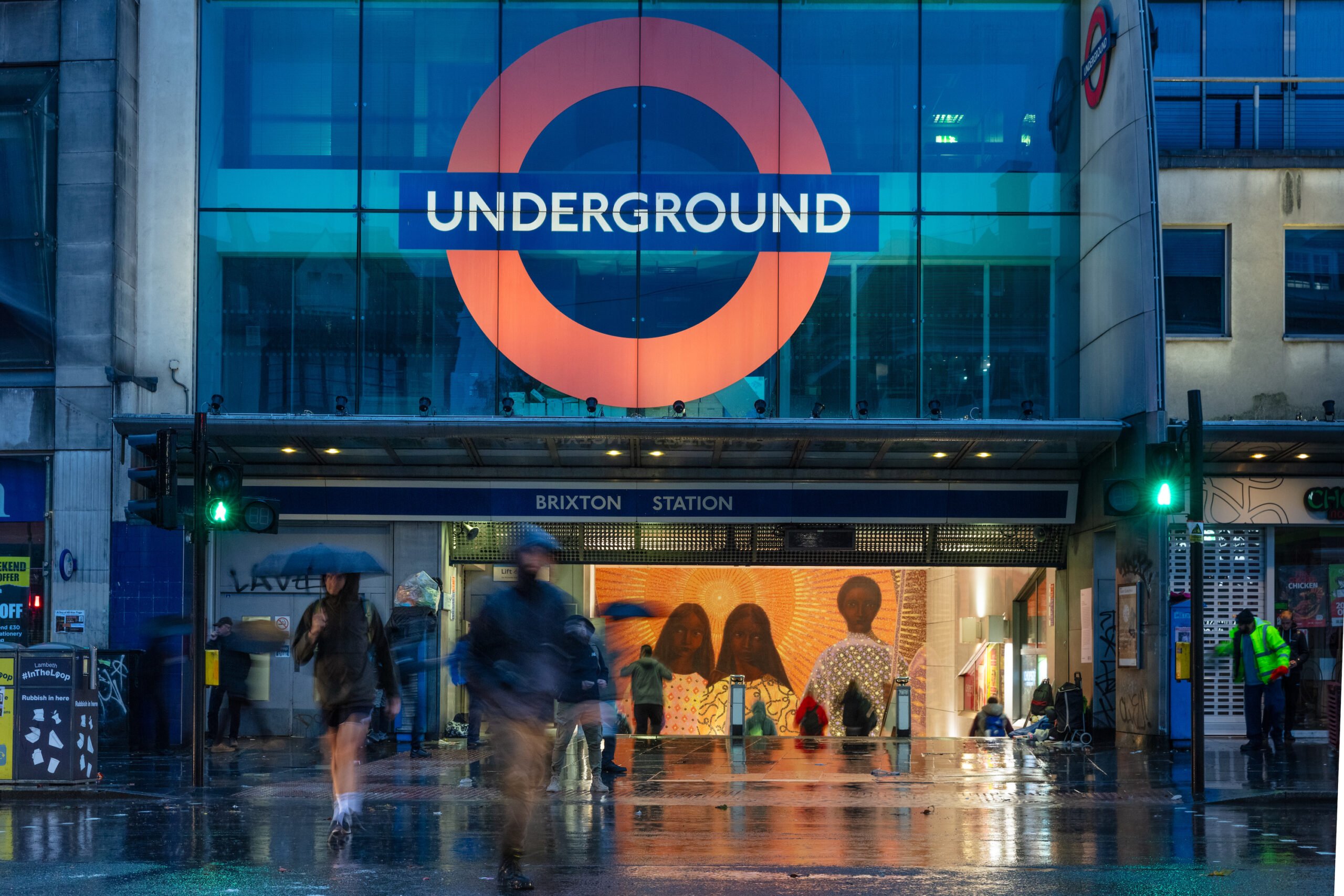
Brixton Underground station’s latest commission, Jem Perruchin’s “Rebirth of a Nation,” launched on 2 November 2023. The mural is the latest of annual works commissioned for Brixton by TFL’s Art on the Underground initiative; since 2018, the expansive overhang as one descends the station’s steps has been variously animated by the works of Njideka Akunyili Crosby, Aliza Nisenbaum, Denzil Forrester, Helen Johsno, Joy Labinjo, and Shanti Panchal.
Six pattern-clad subjects are housed within Perucchini’s composition, arranged in semi-symmetrical pairs. A bright orange background in the evocation of a mandala constitutes an illuminary sunburst; explosive lines of tangerine hues create a halo effect, augmented by the three up-facing spotlights. The first duo of figures flank the composition; visible only of each is a richly-draped arm, their bent elbows overlapping two subsequent male-presenting figures. Both hold staffs, suggesting the occupation of sentry; dressed in identical textiles in divergent hues of olive green and periwinkle, one looks back over the shoulder, and the second stares straight ahead with a proprietary hand on his hip. Central are two female-presenting figures. Dressed respectively in pink and orange, they mirror one another’s gentle gaze, looking in opposite directions. The left-hand figure wears ombre-orange, adorned with interlocking, mosaic-like tendrils; the right-hand figure bears diamond decorations upon her rosy garb and holds a deep-purple orb.
The composition is rich in symbolism; the ethereal figures constitute an allegorical vision – the two foregrounded women constitute the same identity: the present and her future image. The clasped sphere is a multi-layered historical symbol of sovereign power: the orb itself is an object representative of the Crown’s power, integral to the regalia of coronation; the purple hue speaks to the colour of ancient royal uniform – a colour primarily economically and subsequently legally denied to those lacking peerage.

A variety of references are embedded in the work, both contemporary and historical Art. Ethiopian-born Perucchini was raised in Italy; the legacy of his home nation’s artistic history is self-evident in the work’s Renaissance sensibility. The fundamental inspiration for the work is the Ivory Bangle Lady – the moniker endowed upon the occupant of a 4th-century grave of North African origin. Laid to rest in York, archaeological excavations in 1901 found the Lady’s stone-stopping place to contain valuable jewellery and uncommon imports – notably a bangle of elephant ivory. Such accoutrements suggest her personal wealth and nobility, contributing to the validation of the hypothesis that various African citizens enjoyed elite social status within the Roman Empire. Perucchini’s reference of the discovery challenges notions of the blanket subjugation of minority ethnic communities, painting a vision of a more ethnically diverse historical Britain than dominant narratives suggest.
In the sensitive-featured and mild-expression visages of Perucchini’s figures, there is the legacy of Duccio; the Byzantine tradition is enfolded via his use of sharp lines and the absence of shadow. The sumptuous decoration of the subject’s adornments speaks both to the rich textile history of Africa yet imbues the work with a marked modernity. Insofar as the patterns are not particular to the symbology of any one region or country, the work is thoroughly contemporary, its rooting in the diasporic whilst echoing the elaborate detail and diverse artistry inherent to the creation of African wax cloth.
Cycling forward a number of centuries, we arrive at the work’s most abrasive reference – the invocation of D.W. Griffiths’s failure piece, Birth of a Nation. The infamous 1915 white supremacist film is not just three hours of unflinching racist propaganda but also the catalyst that precipitated Hollywood and the formalisation of the film industry – an emblem of the discriminatory machinations that underpin ubiquitous cultural touchpoints. In paying heed to this, Perrucchini challenges us to confront the pervasive exploitation that persists to this day – the erection of civic infrastructure one cannot help but interact with daily, yet built upon the foundations of certain communities’ derogation.

The mural shares its name with Public Enemy and Paris’ collaborative studio album, released in 2006. Reframing and recapitulating Griffith’s derogatory narrative via 19 short pieces for string quartet and electronics, the record constitutes a fragmented and colourful collage; it’s fracturing of African American history echoes Perruchini’s vibrant deployment of pattern – rays of sunlight spilling out from behind the pseudo-religious figures in a geometric constellation. Akin to Terminator X and Professor Griff, so too does Perruchini reposition the narratives of Black bodies: no longer relegated to the sidelines or maligned in the dark, they are front and centre – large, confronting, golden, and magnificent. There is an inextricable connection between the thematics of the album and the visual lyricism of the mural – infused with unyielding class consciousness; it passes comment on the current state of race relations and civil rights. Touching on various references throughout history and culture, the mural illuminates the inequities that persist to this day, though modern iterations may take radically different forms.
Perucchini’s work addends itself not only to Art on the Underground’s offerings but to a long legacy of murals in and around Brixton, commissioned on the back of the 1981 riots. The apex of long-festering racial tensions between the police and Brixton’s residents – predominantly of Afro-Caribbean heritage – the wall adornments were a bid by the Lambeth Borough and Greater London councils as a mode of pacification. The subsequent murals depict scenes of both national and local politics; giving a voice to the voiceless, the murals variously speak to, and tell the truth of the area’s turbulent history and celebrate Brixton’s rich mix of experiences, cultures and stories, illuminating the community and positing a hopeful vision of a more unified future.
Except for those lost due to natural degradation or torn down in the throes of gentrification, the majority of the murals have stood the test of time. At once replicating and bringing Brixton’s history into conversation with its contemporary, there are an estimated fifteen murals still extant, all within walking distance of one another. The closest murals to Perucchini’s work are in Brixton Railway station – painted by Anchor Designs (a partnership between artists Karen Smith and Angie Bitcliffe). The colloquially dubbed “Food Murals” evoke both still life and fresco painting traditions, speaking to the art historical canon in a manner akin to Perucchini’s modern iteration of the legacy of the Sienese School.
One of the city’s most vibrant, multi-ethnic communities, Brixton proliferates with the sounds, stories, hues and histories of a plethora of diverse peoples and voices. With a large population percentage of Afro-Caribbean descent, Perruchini’s mural is a true beacon for the place and times: an exemplification of the long lineage of Black British people, not marked by violence and suppression as is so common in cultural narrations of peoples of colour, but possessed of light and chromaticism, and worthy of celebration. As we stand on the precipice of fascist reversion – a potential second term for Donald Trump in America, swathes of atrocities amidst the Palestinian struggle, and the sweeping growth of far-right and nationalist political parties within Europe – a positive parsing of the Black British story is more vital than ever. The golden-shrouded figures come to stand as a metonym for hope and progress, the subversion of traditional hierarchies of the social and symbolic uplifting past, present, and future examples of Black excellence.
Words by Katrina Nzegwu






